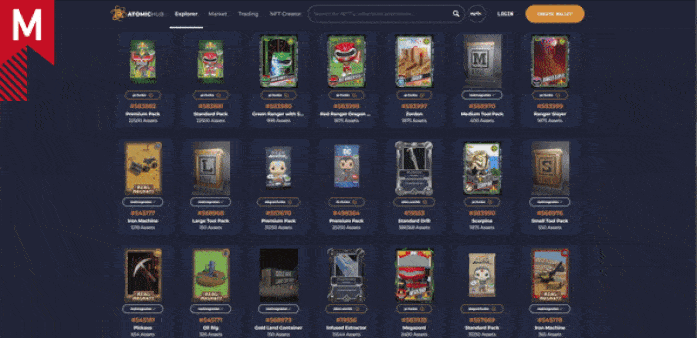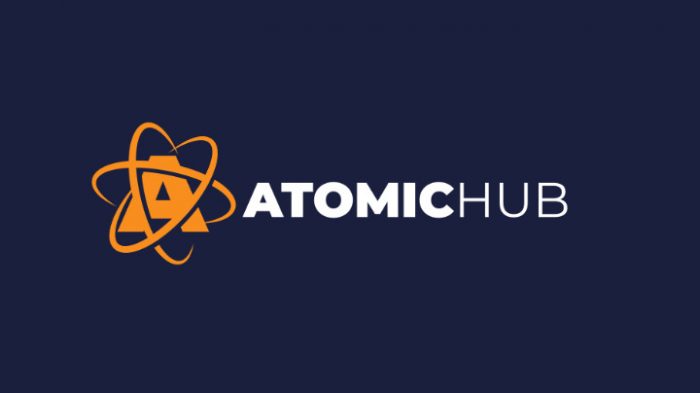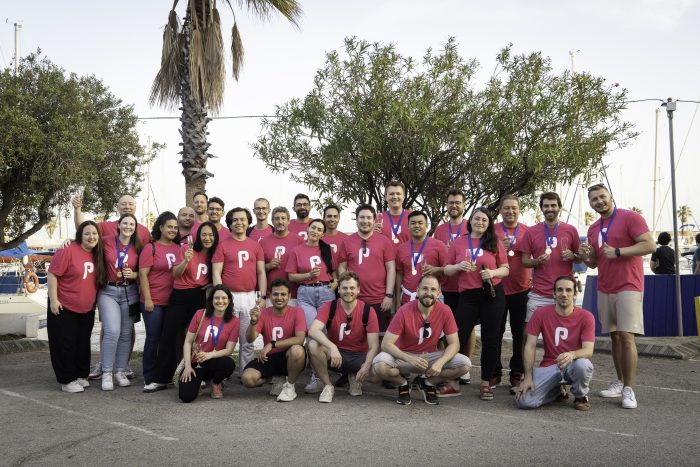Editor’s note
Starting life as a side project for two university friends, AtomicHub has had a meteoric rise, expanding from a two-person operation, as recent as summer 2021, to a team of 35 today.
The NFT marketplace now has hundreds of thousands of users, trading hundreds of thousands of dollars a day.
We’re joined by co-founder Jona Wilmsmann, who candidly discusses figuring out how to run his first company and motivate a large team while operating in one of the world’s most disruptive industries.

Hi Jona. Thanks for being here.
Tell us a little bit about your background.
Hi. Thanks.
Well, my co-founder, Fabian, and I were studying computer science in Munich. We’re actually still officially studying at this very moment (we just haven’t stepped foot in the university in the last two years). We came up with our latest idea whilst there together, but we can probably go even further back.
When we were 12 or 13, we used to order those Panini soccer cards. We got them online because we could get 100 for 40 euros and then resell them at 50 cents apiece.
A few years later, at around 16, we were playing PC games all the time.
What games?
Mainly Counter-Strike. We started trading skins with other gamers on Steam [a digital platform for playing, discussing, and creating games].
We began to get an understanding of digital items, why they had value, and why people wanted to trade them. How having them in a game creates a whole new economy. We even started building our own website to trade skins. We never actually launched it; we were still so young, but even back then, we had ideas.
So, when we first saw NFTs, we were interested right away.
When did you first hear about NFTs?
In 2017 when Crypto Kitties launched. I was already following the Blockchain space a bit. In fact, I was already using Bitcoin as a way of trading CSGO (Counter-Strike: Global Offensive) Skins.
I remember Crypto Kitties’ first big NFT project; they had this genetic mechanic where if you bred two kitties together, you’d get attributes from the parents. But it wasn’t that transparent. You had to get all the data and recognize patterns; I really enjoyed trying to figure it out. It was intriguing, and some people made a lot of money when it started.
How quickly did you get to grips with the technology?
Yeah, pretty quickly, I guess. I was interested in the tech, so I got into it easily. Plus, I was studying, and I was already using Bitcoin.
So, what is AtomicHub?
AtomicHub is the core product we’re building. The easiest way to describe it is: we’re a marketplace where you can create and trade NFTs.
Although, we’re moving further in a social direction. We want to be a focal point for the eco-system, where users can meet people, learn about new projects, and trade.

Tell us a bit about the history of the company. When did it launch? What did it look like at the beginning? How quickly has it grown?
We started working on it in summer 2019. At that time, the WAX blockchain had just begun. We liked it because it was built by the creators of OPSkins, the biggest real-life (real money) marketplace for Counter-Strike. WAX wanted to create a blockchain that focused on digital items (they weren’t called NFTs at the time).
We’d been following the NFT space for a while and were interested in building an NFT game on Ethereum. But the tech wasn’t good enough, and there were gas fees that were too high to make it viable. With WAX, though, we realized we could make it happen. It was just much better suited for NFTs than anything we’d tried before. Our original intention was to play around with the tech and build something cool while we were still studying.
We saw that there was no good technical standard on WAX. On Ethereum, there was already an established technical center for NFTs; on WAX, there just wasn’t yet. So we decided to develop our own called AtomicAssets. But then we knew we needed a marketplace or it would be useless, so that’s how AtomicHub came into reality.
We launched AtomicHub in June 2020, about six months after we started development on it specifically. Even then, we still had the intention of just doing something cool and finally creating our own game, but it very quickly got traction. We got so busy, we just focused on improving AtomicHub.
June 2020? What was your experience of launching a brand during a pandemic then?
We were studying at that time (and technically still are…)
We finalised the project when COVID had just begun and universities were moving online. This process took them a while, though, which gave us time. Eventually, our university said the semesters would go online, but if we didn’t want to study online, we could wait, and it wouldn’t hurt our progress.
So this gave us the freedom to focus entirely on the business and worry about our studies later. It eliminated distractions.
AtomicHub kept organically growing with no marketing; by March 2021, it had exploded. NFTs were getting more hyped. It was still just the two of us and hundreds of thousands of users trading hundreds of thousands of dollars every day.
By now, we realized we couldn’t scale until we hired people. Customer support requests alone build up so quickly.
It took until Summer 2021 for our first employee to start with us.
How many staff do you have now?
35.
What was stopping you hire before this?
We started looking in January 2021, but we had no idea how to do it and where to find good people. Then, even when we did find someone, in Germany, it’s mostly three-month notice periods as well. So balancing finding out how to hire people and running the daily operations was a huge challenge. In the beginning, we were just frantically trying to put out the little fires and work out which features we should focus on and whether we should prioritize business development, marketing, etc.
We eventually found good people, which meant we got things done and made progress.

I was going to ask you what the biggest hurdles you’ve faced as a company are, but I imagine this was one of them.
Yeah, all the big issues have been getting the right people in the right positions and scaling quickly. Not only that, but how do we manage them and coordinate them to work efficiently when we have no experience in doing that? That has always been an issue. Like, how do we hire a business development person if we have no idea how business development works? Then, we had 20 people, and at some point, you need a project manager to put some structure in place.
Just this month, we had our first C-Level hire start as chief revenue officer. We’re super excited to have someone who can lead our business development and growth efforts on an executive level. Until now, we’ve been just figuring it all out on the job.
Thankfully, we’ve met some really smart people along the way.
Let’s talk about some of the issues facing the industry for a moment. What are you doing to mitigate the risk of people being scammed? Especially in an environment you’re trying to make more social.
That’s a very valid point and something, in this context, we’re thinking about a lot.
We’re in a decentralized world, where you can be hard to track down. This invites bad actors. We have to put ourselves in their shoes and see how they can abuse this. It’s the same with fake NFTs. That’s why we have a whitelisting process, so we can be sure what they are putting on the platform is actually theirs!
We’re also big on education. We’re constantly reminding users how not to be scammed. We warn them of possible angles scammers might use and how they can avoid them.
As for the social side of our site that we’re currently developing – we’re imagining a friends system of some kind. So you have to accept a friend request before you can communicate with each other. Eventually, we might even build a reputation system and the facility to report people behaving against community guidelines.
So it’s three things: the friends system, education, and reputation monitoring.
How easy do you find explaining NFTs to people?
Yeah, the shortest version is just digital items on a blockchain.
Most people have some idea of what the blockchain is. I don’t think you need much more than that to get what they are. If you’re talking to someone who has gamed or even played on their phone, they have a concept of digital items. With an NFT, you can create that digital item. Unlike traditionally, where it’s stored on a database on some company’s server somewhere, with an NFT, it’s stored on the blockchain in a decentralized manner, meaning there’s no single entity that can take it away.
Then it gets a bit more complicated if you get into use cases, and why you need it, etc.
You’ve mentioned ‘decentralized’ a few times. Could you explain that?
Up until blockchain came around, everything digital was controlled by someone. If Facebook wants to change the product or block you, they can. If YouTube wants to erase your video, they will. Even a digital item in a game is stored on a server on a database, so someone controls it and can do what they want with it. You’re trusting their word that they won’t do anything malicious. Which in a lot of cases is fine, like if you have big publically traded companies. But, if they wanted to, they could block your account. Essentially it’s giving one entity the power of control.
With NFTs on an AtomicHub (on WAX), we have no permission to take it away. We can restrict access to our site. But we can’t do anything about the NFT. As a creator, if you own this piece of art, you don’t have to trust anyone to store it for you. You just know it’s secured by the underlying technology. It’s basically trust in a central entity is replaced by trust in the technology.
Talk to us about the environmental side of NFTs and what you can do to combat that.
There’s a reason why there is a notion about NFTs being bad for the environment. People think of Bitcoin or Ethereum, where there are these huge mining rigs, or server farms where there are a bunch of computers solving challenges and competing with other farms to be first. This mechanism is important; it secures the network, but it also burns massive amounts of energy, and that energy has to come from somewhere. This usually means an environmental impact.
We’re operating on the WAX blockchain, where it works a different way. WAX doesn’t work by having block producers build huge server farms competing to be first. Instead, it works with the NFT holders voting for 21 block producers. This means they aren’t competing, so they don’t need a warehouse full of servers, which means energy levels are much, much lower. The WAX team is also offsetting the estimated carbon emissions.
We are working with a partner to make our servers carbon neutral, but in the long run, we want to be carbon negative, so we’re working with our users to do that.
What’s next for you guys?
Improving the product:
We’ve always wanted to offer the best possible product and the best user experience. We have lots of ideas: Make it more social. Let people talk to each other.
Scaling the business:
This means getting users, but even more importantly, getting good projects.
Whether that’s finding good partners with existing IP or that are building a game and wanting to implement NFTs. Our vision is that if we help them launch these projects, that in turn will bring in new users.
Are you ever going to build your game?
It’s not on the roadmap right now, but we’d love to at some point.
What was the original idea?
By the time we get to it, I’m sure our original idea will have changed, but a browser game would make it really accessible.
Maybe you have to build something up, and the NFTs represent buildings in the village. What we’d be going for is deeply integrating the NFTs, not just in a cosmetic sense on top of it, but really as core elements of the gameplay. I’m pretty confident we have some cool ideas that haven’t been tried before.
We want to get it to a point where it’s relatively easy to understand but isn’t trivial. Like strategy game that people can really get into, understanding the system and strategizing how to combine the NFTs. I realize that’s pretty abstract at the moment; it’s not a game yet. Ultimately, we’re gamers at heart. That’s what we’re focusing on with AtomicHub: gaming connections and collectibles connections.
What’s the benefit of having NFTs in games?
I think that’s a super-relevant question. We’ve talked about having digital items in a game and the economy it creates, but what’s the benefit of having them in the format of an NFT? In Fortnite, you can also buy skins, but you just can’t trade them. From a user perspective, it’s very simple; they can resell the items if they don’t want to use them. They might want to give away what they’ve used or flip them and make more money.
But why would a developer want to do that? Aren’t they just cutting into their margins, lowering the amount they can sell?
Yes, in a way, it’s just a circulating supply. But what you get is a thriving economy that engages players in a way that hasn’t been there before. CSGO was a popular game, but it really took off when they added skins. All of a sudden, there was this new element of trading, and it got really big. Having tradable items can benefit the eco-system and developers. You can also get secondary market royalties – 3/4/5 percent – on every sale.
The game publishers are no longer selling as much as they can and then disappearing. Not when they have an incentive to keep the game going and the community engaged and thriving.
From a user perspective, it gives you more power. As for a developer giving up the power, that’s where we can educate them that there’s a lot to gain from it.
What tips would you give to people creating and selling their first NFTs?
I’d just encourage people to try it.
There is this fear that it’s going to be super complicated and it’s expensive and there’s gas fees. But try it on AtomicHub. It’s essentially free to get started. It’s a cent to mint NFT (that’s not taken by us, by the way). Getting started is the most important thing.
If you want to move from just ‘trying it out’ to having some sort of success, then the real question is: What value can you add with your NFTs? Maybe it’s the great art you’re creating, and it’s collectible. Or it could be that you’re building a game. You can turn any old JPEG into an NFT, but you have to work out and communicate why people should care.
Last question. Where do you see the evolution of NFTs in the next few years?
I think we’ll see less of the speculative profile picture unique art NFTs. They have value and will still be there but won’t be as prominent.
You think of Bored Apes and Crypto Punks. But it’s niche and catering to high-net-worth people who look at it like high-end art. This has value. But NFTs can be so much more.
In the next five years, we’ll have really high-quality games using NFTs and a community that loves them.
If you’d like to learn more about AtomicHub, you can visit them on https://wax.atomichub.io/




